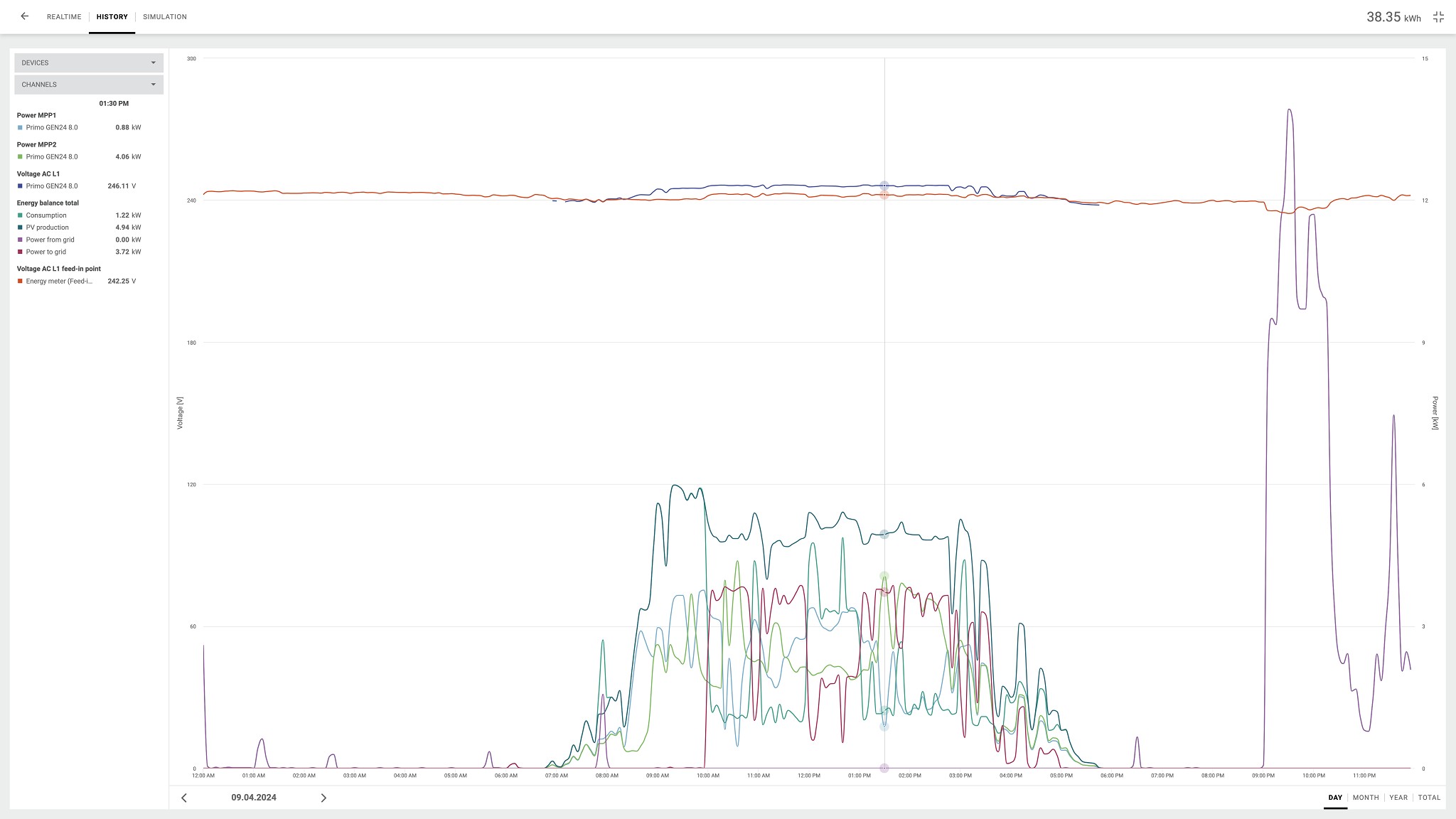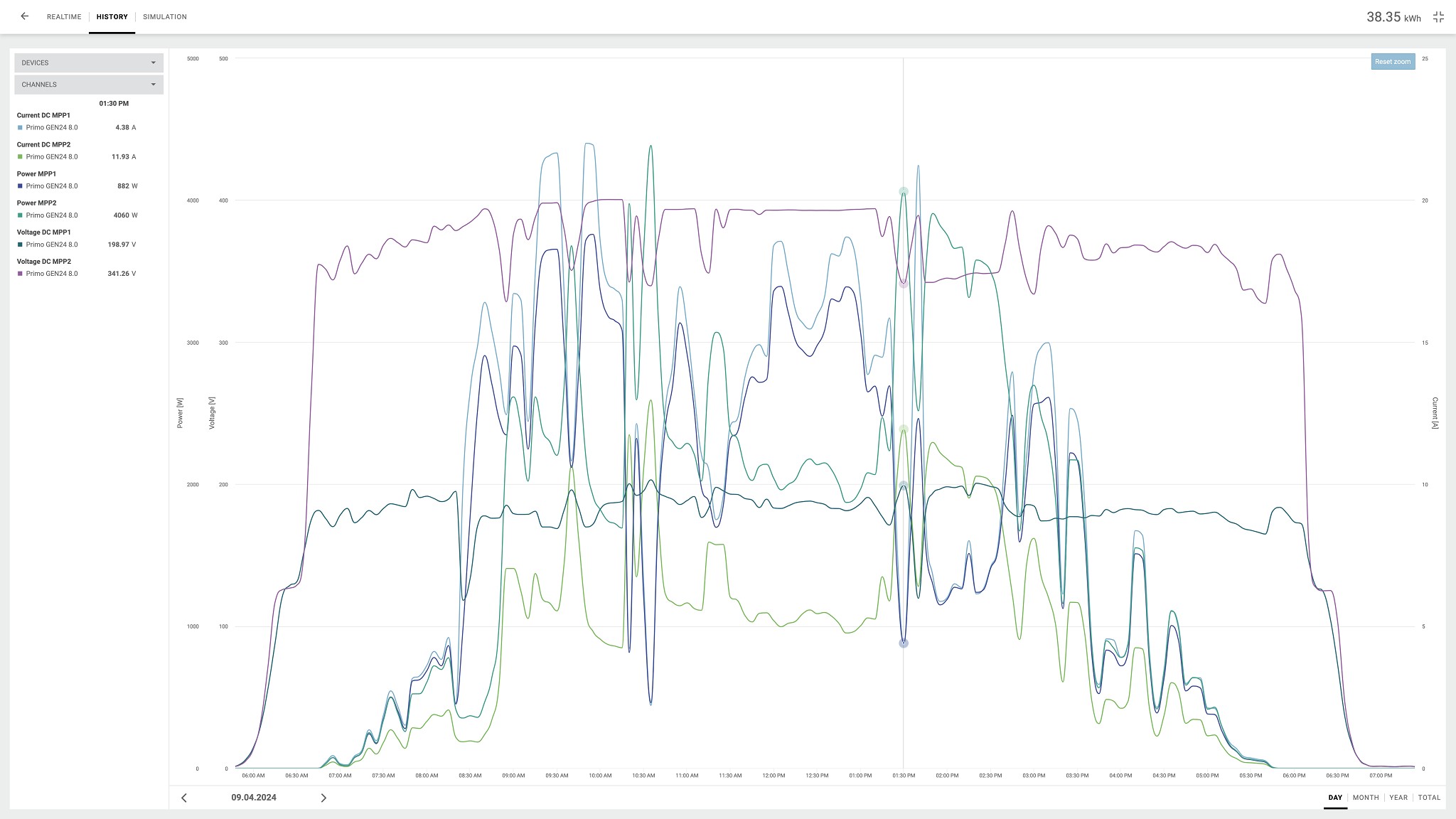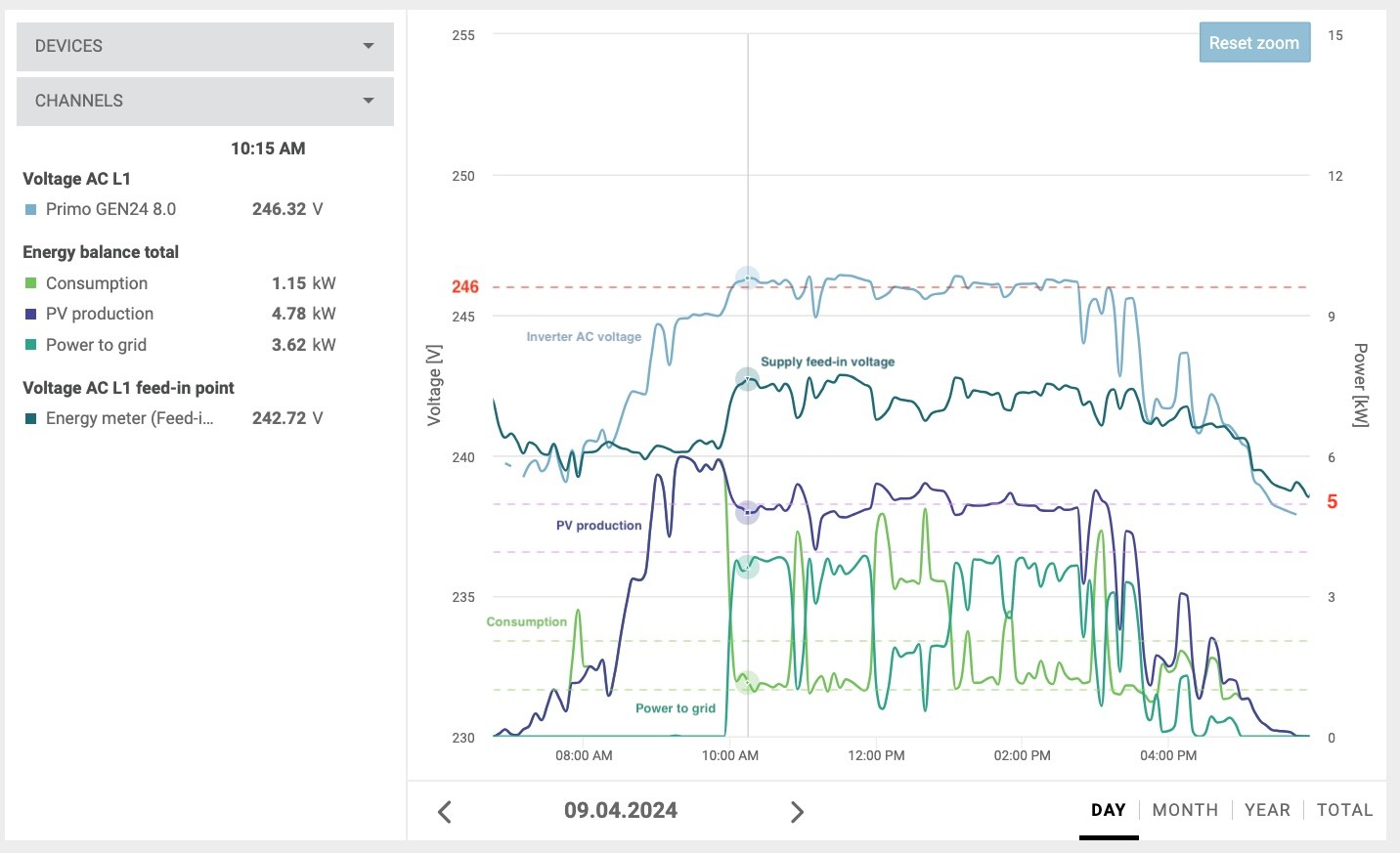|
|
|
I still think that it is the high AC voltage that is causing your clipping, and then the inverter needs to clip one or other or both MPPs.
EgorNZ:
So I've noticed an inverse relationship between the power output from the two MPP's in my solar system. When total output approaches >5kW, one MPP peaks and it's as though something forces the other MPP to dip, like they're coordinating to limit the total output.
What would cause this?
Are you able to run a bunch of heavy usage appliances like aircon, fan heater, oven etc when plenty of sun is shining to eliminate that your 5kW max generation is not due to export limit set which is correct for single phase. Only time the generation will be over 5kW is if your house hold usage is over 5kW or your solar battery needs charging to dump the excess solar there. If your house consumption is negligible and your solar battiers are full, 5kW generation is correc due to single phase export limit.
wongtop:
I still think that it is the high AC voltage that is causing your clipping, and then the inverter needs to clip one or other or both MPPs.
My understanding is the inverter has to operate at a higher voltage (up to +2%) above the grid voltage. So your theory would imply that the problem is with the grid supply voltage being too high? I'm typically seeing my grid supply around 240-242V, with 244-246V from the inverter. If it's clipping due to the 246V limit, does it make sense that this would be correlated with power outputs >5kW?
I should note that my house does have a three-phase supply. But the PV and battery system are all on one phase.
billgates:
Are you able to run a bunch of heavy usage appliances like aircon, fan heater, oven etc when plenty of sun is shining to eliminate that your 5kW max generation is not due to export limit set which is correct for single phase. Only time the generation will be over 5kW is if your house hold usage is over 5kW or your solar battery needs charging to dump the excess solar there. If your house consumption is negligible and your solar battiers are full, 5kW generation is correc due to single phase export limit.
Interesting... You really got me thinking, that might explain things. Weather is dismal today, but when the sun returns I'll experiment to check this. However, I am struggling to believe that in three weeks we've never achieved >6kW generation simply because we haven't consumed enough.
In the previous example where the MPP outputs appear to be clipping, if I overlay the power exported to grid it is well below 5kW at that time:

billgates:That's what I'm thinking. It would be interesting to see your consumption level and total power (kW) overlaid on that last graph for 9/4/24. If there is significant consumption occurring it would be unusual if the total production remained at 5Kw, unless of course it is cloud constrained. Is the export being monitored beyond your primary meter board?
EgorNZ:
So I've noticed an inverse relationship between the power output from the two MPP's in my solar system. When total output approaches >5kW, one MPP peaks and it's as though something forces the other MPP to dip, like they're coordinating to limit the total output.
What would cause this?
Are you able to run a bunch of heavy usage appliances like aircon, fan heater, oven etc when plenty of sun is shining to eliminate that your 5kW max generation is not due to export limit set which is correct for single phase. Only time the generation will be over 5kW is if your house hold usage is over 5kW or your solar battery needs charging to dump the excess solar there. If your house consumption is negligible and your solar battiers are full, 5kW generation is correc due to single phase export limit.
Coincidentally I've taken a look at my data when inverter throttling is happening and it does seem to drop MMP1 rather than share the reduction between the arrays. MPP2 retains its bell curve. Screenshot of this:

https://www.harmlesssolutions.co.nz/
In Solar Web go to Analysis and click on History go to Device and select your inverter and under channels
- Current DC Current MPPT1
- Current DC Current MPPT2
- Voltage DC MPP1
- Voltage DC MPP2
- Power MPP1
- Power MPP2
Take tick them and it should show you a graph. Take a screenshot of that graph. It will give us a way better idea of whats going on.
billgates:
In Solar Web go to Analysis and click on History go to Device and select your inverter and under channels
- Current DC Current MPPT1
- Current DC Current MPPT2
- Voltage DC MPP1
- Voltage DC MPP2
- Power MPP1
- Power MPP2
Take tick them and it should show you a graph. Take a screenshot of that graph. It will give us a way better idea of whats going on.
Here's the same day again with those channels:

do you have a fronus smart meter? Has that been configured? Is it configured on the correct phase?
im guessing it configured for a max 5kW export?
Looking at buyback rates for excess electricity.
We are currently with Z Energy as they have 3 hours free power between 3 to 6 am.
We used to be with Flick as they have very good rates.
Trying to compare buy back rates, waiting to hear from Z, but Flick buys back using the wholesale rate from time to time. See as follows.
In recent times the rate has been over 30 c /kWh which is excellent.
Anyone selling their power back and any idea of the rates over time??
>>
>>
Kia ora Paul,
We hope you are well and stoked to hear you are thinking about getting solar panels installed at your property!
When it comes to how much you will export there is no average amount we can advise, as there are far too many variables involved. Unfortunately, it is a question similar to how long is a piece of string. What we can advise is it dependent on how much energy you are able to generate, and how much of that energy you do not use and therefore export back to the grid. This amount will vary from household to household and day to day.
With regards to our buy-back rate, this will be the live wholesale market price which changes every 30 minutes based on supply and demand. As the price is constantly changing it has the ability to spike high and drop low, so risks and rewards come with having access to the wholesale market rate.
Here is a link to WITS (Wholesale Information Trading System), which monitors the spot price which changes annually every 5 minutes. At Flick, we update the spot price every half an hour to make this more manageable for our customers and for our systems! WITS has a lot going on, please direct your attention to the top right-hand corner, it's a grey map of Aotearoa with coloured boxes floating around it. Focus on the box nearest your region and read (for example) $123.45 as 12.345c/kWh.
Please note that a limitation of our online tools is you will not have access to the live wholesale market price, therefore if you wanted to see the current spot price you would need to use the WITS website. You will however have access to your export and imported data on your dashboard, which you can view at a daily, weekly, or monthly breakdown.
If you get solar installed at your property you will need to get a meter upgrade so that your meter measures your exported units. If you will be with Flick during this time we will need you to complete this online form here to get the ball rolling. By doing this, you will be added to our Home Harvest trial. The full terms of the trial are available here.
If you have any further questions, please feel free to give us a bell on 0800 435 425 or flick us back an email.
Let me know if you have any other questions!
Ngā mihi,
Phoenix
the buyback rate is high in peak times, its currently about 30c for Auckland and it's pouring with rain, not going to be selling much back at the moment. Then come middle of summer when sun is plentiful and the rate will be less than 10c.
Most people hedge their bets and get a plan with a high buyback rate like mercury/meridian are offering, or go for one with a lower one (~12c) that has half price night rates. or something similar.
I feel like its too easy to get burnt by wholesale rates
prob:When I contacted Z a few months back they advised that they do not offer any facility for FIT for customers with distributed generation.
Looking at buyback rates for excess electricity.
We are currently with Z Energy as they have 3 hours free power between 3 to 6 am.
We used to be with Flick as they have very good rates.
Trying to compare buy back rates, waiting to hear from Z, but Flick buys back using the wholesale rate from time to time. See as follows.
.......
https://www.harmlesssolutions.co.nz/
Interesting the comments at the end of this news piece from TVNZ tonight, from Octopus but not credited as such.
https://www.harmlesssolutions.co.nz/
Jase2985:
@EgorNZ any updates?
Weather conditions have been up and down for the last week or so, but I keep going back to this chart for 9 April. The more I look at it the more convinced I am that @wongtop is right, the voltage is key.
It shows:

Guy from Harrisons came to take a look at the problem a few days ago. They're going to follow up with the electrical contractor who did the install to investigate further.
He agreed that the 246V limit theory is a possible explanation. There is an 11kVA transformer right by my front gate, so he suggested it's possible we're the "first" property on the circuit, and Vector may have cranked up the supply to deal with lower voltage further down the road. If that is the problem, we'll be at the mercy of Vector to resolve it.
|
|
|
